Heath Rezabek, an Austin, TX-based librarian, futurist and long-term thinker, continues the chronicle of his evolving work on the Vessel project and its ramifications. Developed as a strategy for preserving our cultural and biological heritage, Vessel is inevitably a way to re-examine ourselves in new and startling ways. Science fiction offers a supple way to visualize what generations in the near and far future may draw from such archives, leading perhaps to created intelligences that grow by sampling our imagery, our artifacts, our mythologies. In the passage that follows, we meet an SF writer named Thea Ramer, and learn more about Dr. Kaasura, whose early work with Vessel points to synthetic minds, re-woven patterns of quantum reality and the development of Saudade-class starships. But let Heath explain…
by Heath Rezabek
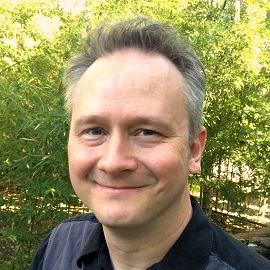
This is the third installment in a continuing series of speculative fiction here on Centauri Dreams. Feedback from prior installments helps shape the themes and direction of subsequent entries, as we continue to explore a timeline in which comprehensive, resilient archives of Earth’s resources are developed through unexpected means.
One organizing principle in my work on comprehensive archives is the fact that interplay and overlay of seemingly disconnected concepts can bring about unexpected connections, due to the way the mind tends to see wholes when confronted with parts. In this spirit, the story here begins to loop back to prior events as possibilities unfold and multiply, bringing speculations from prior comments into the storyline. Although the second installment, Starships: Sentient Habitats is referenced, it’s also useful to revisit the first installment, Vessel: A Science Fiction Prototype and the comments for both.
For those most interested in the Vessel project proper, it continues as a background process while awaiting an opportunity to develop it more fully. My internship assisting with the Long Now Manual for Civilization project is picking up speed. The first, second, and third nonfiction working logs for the Vessel project can be found as linked.
This current fictional installment had many inspirations. Much to my own surprise, very early on a crack was opened up which led back to fictional groundwork laid in collaborative writing projects twenty years ago. At the time, I had become fascinated by the scenario of recurrent collapse which still left an adaptive civilization remaking and rebuilding from the ruins of the prior. Even then, I now realize, deep archives were present. It would be two decades before I’d encounter Nick Bostrom’s Xrisk subtypes of Permanent Stagnation and Flawed Realization, which lend new tools in excavating this interglacial culture.
Do our possible futures widen and narrow depending on what we feel able to visualize? The thought of probability doors opening and closing as ideas like starships or streetpunks gain and lose ascendancy was a startling visitor as I reconciled recent feedback.
There is one thematic guest in this installment, and there would have been two more had I not reached a certain cusp that begged me to cliffhang them. The thematic guest that stayed was a Jungian visualization technique from the field of psychology, called Active Imagination.
During Carl Gustav Jung’s split with Sigmund Freud over the extent to which the human mind was bound or could move beyond its primal instincts, he developed a visualization process which was to shape his work for the rest of his career. Common concepts such as archetypes, the shadow, the animus and anima, synchronicity, and many others emerged through his initial work with the technique.
There are various ways to carry it out, and one of them (verbal) works more or less as demonstrated by Dr. Kaasura here. Key to the process is not to impede or try too hard to redirect the stream of thought as it is expressed, while describing what arises and how you interact with it. Some liberties were taken for the purposes of exploring story details, but the visual objects in Dr. Kaasura’s session are drawn from this process.
The sciences have a strange but real history with regards to dream or the unconscious as a source of inspiration, as noted in the narrative (Einstein, Poincaré, Kekulé) and detailed in Hypnagogia: The Unique State of Consciousness Between Wakefulness and Sleep[1]. For more on the process of Active Imagination, see Jung on Active Imagination[2] and The Red Book[3].
This installment asks more of Centauri Dreams readers than others, in terms of straying outside of the bounds of topics normally found here. In return, we’ll at least get to revisit some things that might have slipped past in prior installments.
The next installment will reward our detour with a dive into some key habitat technologies, one foreseen by Bucky Fuller, and the other by Freeman Dyson. But sometimes, to find a trail again, you have to take a path through the undergrowth…
[1] Mavromatis, A. Hypnagogia: The Unique State of Consciousness Between Wakefulness and Sleep (Thyrsos Press, 2010).
[2] Chodorow, J. Encountering Jung: Jung on Active Imaginaton (Princeton University Press, 1997).
[3] Jung, C. G., Shamdasani, S. The Red Book. (W. W. Norton & Company, 2009).

Image: (The Tracer Guild: A Novel by Thea Ramer. 1994) Art by Joshua Davis.
– – – –
The light blinked, and darkness collapsed around Tracer Aakanthia [9T33], its momentary mission complete. Gently lifting the cubic shard, it hovered and drifted back towards an array of its own, a cellular framework of woven carbon splines leading it fore towards the sail sections, slipstreaming starward…
– – – –
Thea Ramer hung up the phone, the words of her editor still ringing in her ears. “This is the nineties, Thea. Nobody at Omni or anywhere else wants a story about robots on starships. Call me when you have some cyberpunk.”
She sat there, facing her draft, flickering on the screen of her Centris. No heir to the habit of throwing things away, she hit return a fistful of times and began again.
– – – –
Dust, undisturbed for centuries, billowed as it came suddenly to life. A ripple and a shiver passed through it, a tiny aftershock of slumbering thought. The dust belonged to a molecular mind, and the mind belonged to no-one but itself. Its origins forgotten, its purpose obscured by time and oblivion, this fog of dark mind encased and enshrouded the scaffolding woven here through rubble and debris. Deep below ground, like shredded shadow it hushed, seeking slowly the cracks between this world and the–
… . . . . . .
–seeking slowly the cracks between the virtual and real. The Tracer Guild it was called, drifting like an orphan–
… . . . . .
The Tracer Guild, drifting like an orphan between citastates aboveground, had followed it here–
… . . . . . . .
Far above, in the streets of the bazaar, a lone Tracer pulled his hat low over his brow, sheltering his gaze from hazy sun. He had just disembarked from the caravan’s road, seeking the albino traders for which this place was known. They sought the underground, delving in the deeps, and came back with the strangest of wares.
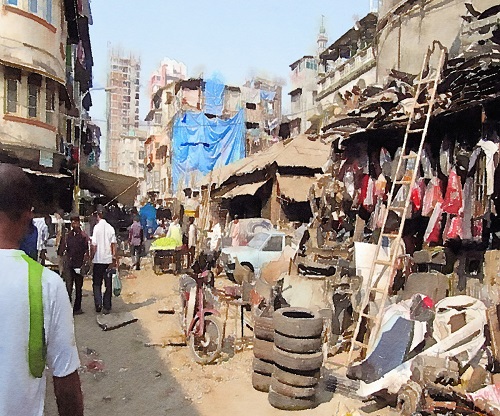
Image: Based on a photograph CC BY Wally Grom.
Vaachez was in need of a map, if all else failed; but what he really wanted was an albino guide. The very best, it was said. For them the deeps were home.
He aimed to descend, below the streets and tents and scaffolds. Far below ruins, the Orphan Obscura was rumored to dwell, binding itself to… something. To what? Those in the Tracer Guild weren’t sure what, or why. They had spent their whole existence trying to find out. Perhaps it was a port; perhaps it was a cache; perhaps it was nothing that belonged to the lost network — Ancient Light — though that seemed unlikely given everything else.
Because everything else had led to this place. And word on the lightweave was that this place was one of only a few, scattered around their dusty globe. If so, then it was truly huge: it was said to splay beneath the ruins of many a rebuilding.
Vaachez wrapped his cowl against the desert wind and made his way down into the long-dried riverbed that cut through Ityl-Atys. And he was lost to the cacophony of the bazaar.
– – – – –
Thea sighed, rubbing her eyes as she pushed her chair away from the work.
It wasn’t exactly cyberpunk. But it was where the work was taking her; she had to follow it through.
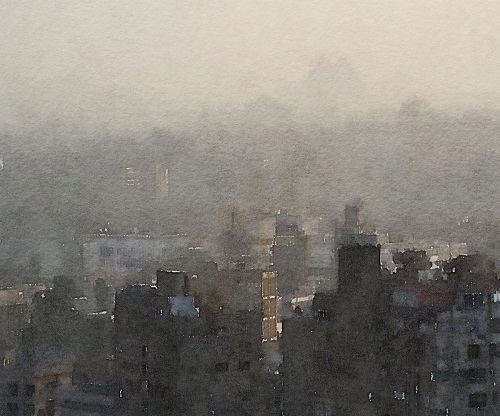
Image: Based on photograph CC BY Nina Hale.
– – – – –
When Dr. Kaasura envisioned Augmented Dreamstate technology, he could not have guessed that it would have a key role to play in the design of Avatamsaka, the synthetic mind that would someday be woven into Saudade class starships.
In fact, he could not have guessed such a union would come to be at all. Between his time and the most persistent of quantum futures lay an array of massive transformations, most of which resulted in an Earth far different from the one he knew.
The standard roadmap for the development of artificial intelligence began in familiar places, but led from his here and now to wildly divergent outcomes. Unthinkably advanced artificial minds – artilects – were an emergent probability which was difficult to plan for or against. In these timelines, early artilects quickly reached a stage where their capabilities outgrew their constraints.
In most such timelines, the subsequent goals and strivings of these beings, once born, were resoundingly alien to anything we would recognize as human or Earthly. Gestures small and great to reroute the unfolding scenarios tended towards a reweaving of those strands back into the patterns they’d sought to avoid.
Nearly every route through the probability fields governing such development efforts ended up warped and gathered towards massive attractors: myriad future timelines in which artilects subsumed all around them, for better and for worse.
Consciously avoiding these outcomes was nearly impossible; the idea of unconsciously avoiding them had not yet occurred to anyone. Augmented Dreamstate would, unwittingly, open new passages that led to timelines tucked in amidst the massive thoughtflows of artilect minds: the seeds of dreams; synthetic memories.
Inhabiting such whorls in seas of probability would not, in the end, wholly insulate from timelines much more massive; but Augmented Dreamstate would allow the founding of a sort of niche in spacetime, like a tidal pool of remembrance, awash in strange, strong seas.
And that is for the future.
At the time of our tale, there in the thick of the early 21st century, Dr. Kaasura’s goal had been quite practical and immediate:
He sought to create a simple, guided platform for immersive and therapeutic simulations in which subjects could come to grips with particular experiences of survival. Most had lost everything but their lives in what we call natural disasters.
These phenomena – earthquakes, floods, landslides, hurricanes, meteoroids – bore a unique trait: they were invisibly caused, impersonal and inhuman. And massive, usually, in their reaches and impacts. Through guided visualizations, survivors could approach and process their own paths through the immensities of such events.
The theory was based on verifiable experiment, though the only apparatus needed was an attentive mind. Augmented Dreamstate had been based on taking a very practical Jungian visualization technique called Active Imagination, and then stabilizing and guiding it through the assisting role of deep learning algorithms and virtual suggestion.
In time, the mind called Avatamsaka would evolve from this role. At the start, however, Augmented Dreamstate was about crafting a symbolic feedback loop.
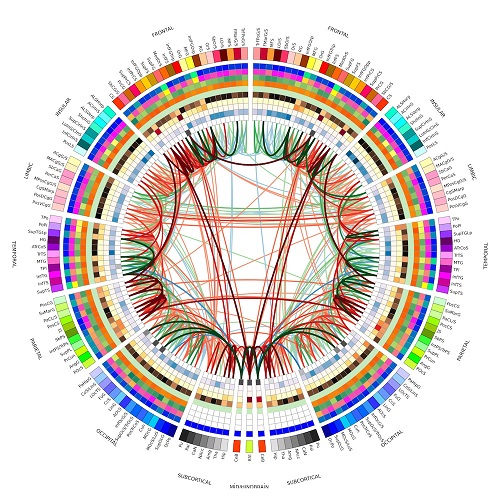
Image: Double Connectogram. CC BY-SA Wikimedia Foundation.
Dr. Kaasura had come to Vessel Labs in part because the deep archives they were compiling would be so useful as input. In this case, Vessel’s random pool of mythological, symbolic, and archetypal imagery had been tapped as a good stimulus for the nascent pattern-sampling algorithm underlying Avatamsaka’s earliest builds.
Recording logs of participants’ Active Imagination sessions, Dr. Kaasura would use vocal processing to leaven their imagery with the standardized maelstrom of imagery and symbolic data cached as part of the Vessel project. All of it would be pooled and reshuffled with data from others, creating a split prism of humanity’s heritage.
The system-who-would-be-Avatamsaka would then pattern-sample from the pool, trickling a stream of linked fragments into visual, auditory, and neural interfaces worn by the dreamer. What resulted was a space in which immersive narratives could be sustained by and for the subject, as they explored and interacted with these refined projections within their own minds – and eventually, within the minds of others.
In the early days, half of the process was plainly visible, because it had been shaped by voice. Before vocal interface had been perfected, this process would have been impossible, at least in its synthetic form. Yet by Dr. Kaasura’s time, the first Vessel archives had been opened to simple pattern sampling via vocal interface. To an outside observer, active imagination and early Augmented Dreamstate appeared quite nearly the same.
After 10 years immersed in research into aspects of the problem, the insight which led Einstein to formulate his Theory of Relativity arrived as he rose from sleep one morning. Henri Poincaré, after too much black coffee one evening, witnessed a colliding of concepts and images in pairs until he was able to sift from the soup a proof of the existence of Fuchsian functions and automorphic forms. August Kekulé perceived the benzene molecule, spinning as an ouroboros ring, while he dozed by the fire, turned away from the frustrations of his work.
Though mention of these instances were rare in annals of scientific inquiry, long ago they had suggested to a younger Jota Kaasura that the mind was an untapped wellspring whose fruits could manifest in many ways. Years later, Dr. Kaasura would synthesize the computational concept of Augmented Dreamstate during his own practice of Jungian visualization and Active Imagination, while preparing the program for the sampling of other participants. At first, the symbiotic role which would in future generations be played by Mentor AI was reflected through the responses of his inner world to his own questioning attention.
Some of these logs have been preserved. Their authenticity cannot be proven, and so they remain curiosities. For those seeking insight into the development of Augmented Dreamstate technologies, however, they remain a useful resource.

Image: Based on a photograph CC BY-SA Mark Nightingale.
Active Imagination Session Log, Thursday February 5th, 2023
This is another test session of Active Imagination, as described and developed by Carl Jung.
Starting image: The seashore, up the road from the power plant. Day of the storm.
[Pause in log]
I’m looking down the road towards the plant. The winds are up, and I can see dark clouds gathered beyond the plant, out to sea. Not so far out.
On the sides of the road, stalks of bamboo are swaying, rippling, standing firm by yielding. I pull my hat down and push the weeds aside. Old cars are motoring away from the plant, up the road past me – I move to the side, into a ditch, to get out of the way. I start to make my way towards the plant.
The tide is crashing now, a quarter mile down the road, against the sides of the plant. Steam billows up with each wall of water which pounds on its walls. The road is in gridlock – the trucks have all stopped, and some people are getting out of their cars. No-one but me is heading towards the shore.
I stop and look. With each gust of wind, the trees and bamboo bend away from the storm. Alarms are bleating at the plant; a yellow warning beam is spinning like a lighthouse beacon on top of one of the coolant towers. I don’t know what to do.
A white truck on the road above me rumbles to life, and starts to move as if it’s going to try and go offroad, around the traffic, up the hill. It plows down into the ditch, and grinds on – another 10 yards… It stops, wheels spinning in the rain and muck. It roars again, and plows another 15 feet in one lunge. It’s starting to tip.
I back up, off the road and onto the path above the truck. It tips over, crashing down, and a driver clambers up and out the passenger window, dropping to the ground to run for it on the other side of the truck. The bed of the truck is breached. Several crates tumble out. They’re all about 4 or 5 feet across, each different.
I look back towards the plant. The road is empty of people now, and it’s just abandoned cars and rising water and steam and the crates and me. The rain is a cold curtain and I can’t see beyond the walls of the plant, but there’s a groan of steel on steel with each wave.
Turning towards the hills, I can see them tumble into the foothills of a mountain range – which I don’t remember from visiting the wreckage again last year. The path goes up, towards a cleft in the wall of the mountain.
I feel the need to save these crates, but there are too many to carry. I look at them – there are three here. One wooden, one metal, one of some white material. It almost looks like vintage styrofoam. It’s lashed with a harness of orange straps. I push at the wooden crate with my foot – it’s heavy, waterlogged. The metal crate makes me tired just to look at it. I nudge the white crate; it’s almost too light, though the case is definitely not styrofoam. I grab one of the orange straps and turn up the path. I’m soaked to the bone.
I begin pulling it towards the cleft in the mountain wall. The white crate slides on the grass, heavy now but manageable. I look back over my shoulder, but can barely see the orange light in the flotsam. Everything is a roaring, like the sea is made of engines. I pull.
I’m still a hundred yards from the cleft, and it feels as if the wind is pushing me up the hill now. My hat is gone. I have no idea when. It’s so close – the edges are steep, a carving or crack in the rock face. It’s a slender V shape, with a thick timber beam up a dozen feet above, more like an upside-down A. Above the beam I can see a ceiling running back into tumbling stone which fills the upper crevice.
Behind me the wind is thick, sharp, lashing my neck with rain. I’m nearly there; I can hear debris clatter and clap against the crate. I can’t look back.
I reach the crevice with my crate and strap it on, like a giant backpack. It lifts, much heavier to me than it was down below. I nearly fall backwards. My legs are trembling; I look into the crevice. It’s dark, slick stone, almost black; about 20 feet into the passage it cuts to the right, into deeper stone. I make my way in.
There is some kind of chimney or chamber leading up and down. There’s a ladder, slick metal rungs, sunken into the stone face. Something behind me gives, and there’s a sound like a crashing car, but slower and growing. I refuse to look back – I’m at the ladder, and down below there’s a deep blue glow. Up above me there’s a bluish glow as well, but brighter, aquamarine, greenish. Neither is too welcoming. Water is running past my feet, and down now, churning into the chamber. Sticks clatter on the ladder as they fall.
I start to climb – my left shoe tumbles down in, full of muck, as I raise my feet. The air is a furious spray. Climb. I climb.
A dozen feet above me the light grows brighter, and the chamber widens to a ledge. There’s bioluminescent moss, or something like it, veins of it growing in cracks, splicing the ceiling. I hear a near, sudden silence below as I pull myself up and over the ledge, the crate tumbling over my shoulders and pulling me over and into the room. Then below it’s all sea engines, and the ground shakes with a blast of water and creaking debris.
I sit up, shake my head, full of noise. I fling off the orange straps like they’re going to pull me back down the vent. Standing, breathing, catching my breath. I catch my breath. Six deep breaths.
[Pause in log]
The waters fade back behind me, like rain. I’m not looking back down the chamber.
Squinting, I can see fairly well into the luminous grotto. Shallow steps arc down a few feet, and I take them. The ceiling goes on for some yards, a good six feet above my head now. There are other passages off in the distance of the cavern, but they’re blocked by –
Well, and so there in the middle of the floor, lies a wooden and a metal crate.
Mine is tumbled up against them, lid off, lying open.
– – – – –
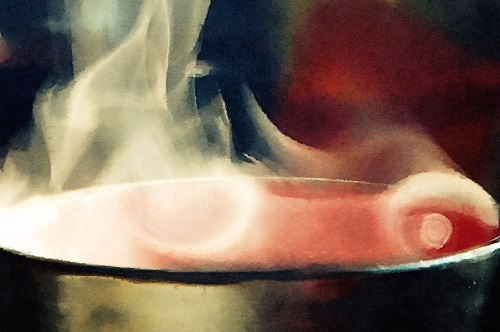
Image: Based on a photograph CC BY-SA Mark Nightingale.
Aben Ramer blinked, bright sandy sky stinging his eyes. He’d dozed off, there in the camp in the pre-dawn hours, having settled down in a spot where he could hear several of the team discussing their projects with others who’d been here during the sandstorm.
He had drifted off with a clear and shifting image of that white dwarf in his mind, gazing impossibly into still-brilliant depths of unfused carbon, diamond soot, dust intaglio. Were those memories he’d imagined written there, or just some waking dream of falling heat?
He watched the steam slowly rising from a tin cup of cowboy coffee sitting over by the threshold, lent life and fleeting form by the rising sun, and wondered what the difference was.
He’d met several members of the installation team back at the holographic timeline exhibit. He knew what he wanted to do. He knew what he wanted to be. Soon it would be time to pack, and to go.
These words, in his mind as he drifted once more:
“For matter is slumbering light.”



Consider the communication strategy of the micro-diaspora. A spherical shell one cell in thickness of radius that of Earth’s surface with one cell every square micron quickly thins out. By 10 LY out, 10^8 x 10^8 Km is the surface area containing one single cell. This strategy is not recommended.